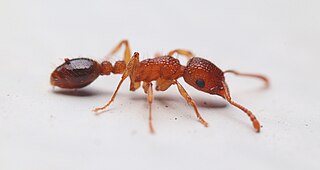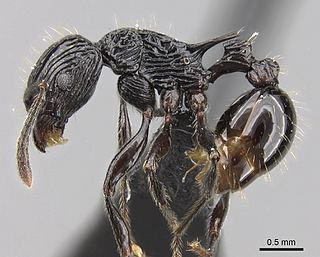
Tetramorium atratulum is a rare workerless socially parasitic ant from the Palaearctic region, which has even been introduced together with its host in North America. This extreme inquiline is represented only by female and pupoid type male individuals, whose morphology and anatomy indicate a highly specialized level of parasitism. The body of males is depigmentated, the cuticle is thin, the petiole and postpetiole are widely connected, and degenerate mandibles, palps, and antennae are observed. Female wing venation is reduced and the occipital region is narrowed. Mature females are typically physogastric and found in queenless host nests.

Lansium parasiticum, commonly known as langsat, or longkong in English; duku in Indonesian or dokong in Terengganu Malay, is a species of tree in the Mahogany family with commercially cultivated edible fruits. The species is native to Southeast Asia. Despite its name, it is not parasitic; the specific epithet parasiticum derives from the fact that it can grow as an epiphyte in the wild, which was once thought to be an indication of parasitism.

Tetramorium immigrans—also known as the immigrant pavement ant, pavement ant, and the sugar ant in parts of North America—is an ant native to Europe, which also occurs as an introduced pest in North America. Its common name comes from the fact that colonies in North America usually make their nests under pavement. This is one of the most commonly seen ants in North America, being well adapted to urban and suburban habitats. It is distinguished by one pair of spines on the back, two nodes on the petiole, and grooves on the head and thorax.

Dollman's tree mouse is a poorly understood climbing mouse from central Africa. It is unique enough that it has been placed in a genus of its own, Prionomys, since its discovery in 1910.
Tetramorium mayri is a species of ant in the genus Tetramorium. It is endemic to India.
Tetramorium schmitzi is a species of ant in the genus Tetramorium. It is endemic to Israel.
Tetramorium kutteri is a species of ant in the genus Tetramorium. It is endemic to Spain.

Tetramorium inquilinum is an ectoparasitic ant found in Europe. It was discovered by Swiss myrmecologist Heinrich Kutter. The species is unusual for lacking a worker caste, the queens and males living entirely off the care of the pavement ant. It has been called "the 'ultimate' parasitic ant" by myrmecologists Edward O. Wilson and Bert Hölldobler.
Tetramorium microgyna is a species of ant in the genus Tetramorium. It is found in South Africa and Zimbabwe.

Tetramorium is a genus of ants in the subfamily Myrmicinae that includes more than 520 species. These ants are also known as pavement ants.

Scleropyrum is a genus of trees in family Santalaceae first described as a genus in 1838. At present, only one species is recognized, although several others are listed as "unresolved," meaning that further research is needed to determine affinities.

Tetramorium caespitum, also known as the pavement ant, is a species of ant in the family Formicidae.

Amoebidiidae is a family of single-celled eukaryotes, previously thought to be zygomycete fungi belonging to the class Trichomycetes, but molecular phylogenetic analyses place the family with the opisthokont group Mesomycetozoea. The family was originally called Amoebidiaceae, and considered the sole family of the fungal order Amoebidiales that included two genera: Amoebidium and Paramoebidium. However, Amoebidiidae is now monogeneric as it was recently emended to include only Amoebidium. Species of Amoebidium are considered obligate symbionts of freshwater-dwelling arthropod hosts such as midge larvae and water fleas (Daphnia). However, because Amoebidium species attach to the exoskeleton (exterior) of the host and grow in axenic culture, at least some species may be facultative symbionts.

Tetramorium bicarinatum, is a species of ant of the family Formicidae in the order Hymenoptera that originated in South East Asia.

Dysoxylum parasiticum, commonly known as yellow mahogany, is a species of rainforest tree in the family Meliaceae native to Taiwan, parts of Malesia, Papuasia, and northeast Queensland.

Tetramorium nazgul is a species of Myrmicine ant native to Analalava, Ambohijanahary, and the Zombitse-Vohibasia National Park, Madagascar. The species is characterized by long, thin, propodeal spines. Its body is covered in a multitude of long hairs. General coloration is dark brown or black, with lighter coloration on the legs. The species is commonly found in leaf litter in tropical dry forests and montane rainforests, typically around elevations of 700 to 1,100 meters. It was named after the Nazgûl from J. R. R. Tolkien's The Lord of the Rings.

Tetramorium smaug is a species of myrmicine ant native to Ambatovy, Amber Mountain National Park, and Ivohibe in Madagascar. It was found in montane rainforests around elevations of 900–1,300 metres (3,000–4,300 ft). It is believed to live in vegetation as opposed to on the forest floor. Coloration is dark brown or black. The head and mesosoma have rough surfaces while the gaster is smooth. The head has a large number of hairs, but the amount of hair decreases on each segment posteriorly. The species has long propodeal spines with a broad base. It was named after the dragon Smaug from J. R. R. Tolkien's novel The Hobbit.
Tetramorium yerburyi is a species of ant in the subfamily Myrmicinae. It is found in Sri Lanka and China.












